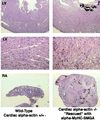Rescue of cardiac alpha-actin-deficient mice by enteric smooth muscle gamma-actin
- PMID: 9114002
- PMCID: PMC20735
- DOI: 10.1073/pnas.94.9.4406
Rescue of cardiac alpha-actin-deficient mice by enteric smooth muscle gamma-actin
Abstract
The muscle actins in higher vertebrates display highly conserved amino acid sequences, yet they show distinct expression patterns. Thus, cardiac alpha-actin, skeletal alpha-actin, vascular smooth muscle alpha-actin, and enteric smooth muscle gamma-actin comprise the major actins in their respective tissues. To assess the functional and developmental significance of cardiac alpha-actin, the murine (129/SvJ) cardiac alpha-actin gene was disrupted by homologous recombination. The majority ( approximately 56%) of the mice lacking cardiac alpha-actin do not survive to term, and the remainder generally die within 2 weeks of birth. Increased expression of vascular smooth muscle and skeletal alpha-actins is observed in the hearts of newborn homozygous mutants and also heterozygotes but apparently is insufficient to maintain myofibrillar integrity in the homozygous mutants. Mice lacking cardiac alpha-actin can be rescued to adulthood by the ectopic expression of enteric smooth muscle gamma-actin using the cardiac alpha-myosin heavy chain promoter. However, the hearts of such rescued cardiac alpha-actin-deficient mice are extremely hypodynamic, considerably enlarged, and hypertrophied. Furthermore, the transgenically expressed enteric smooth muscle gamma-actin reduces cardiac contractility in wild-type and heterozygous mice. These results demonstrate that alterations in actin composition in the fetal and adult heart are associated with severe structural and functional perturbations.
Figures





Similar articles
-
Mice lacking skeletal muscle actin show reduced muscle strength and growth deficits and die during the neonatal period.Mol Cell Biol. 2002 Aug;22(16):5887-96. doi: 10.1128/MCB.22.16.5887-5896.2002. Mol Cell Biol. 2002. PMID: 12138199 Free PMC article.
-
The development expression of the rat alpha-vascular and gamma-enteric smooth muscle isoactins: isolation and characterization of a rat gamma-enteric actin cDNA.Mol Cell Biol. 1988 Dec;8(12):5224-31. doi: 10.1128/mcb.8.12.5224-5231.1988. Mol Cell Biol. 1988. PMID: 3244353 Free PMC article.
-
Cellular disorganization and extensive apoptosis in the developing heart of mice that lack cardiac muscle alpha-actin: apparent cause of perinatal death.Pediatr Res. 2004 Feb;55(2):197-204. doi: 10.1203/01.PDR.0000100900.56627.E1. Epub 2003 Nov 6. Pediatr Res. 2004. PMID: 14605248
-
Cellular distribution of smooth muscle actins during mammalian embryogenesis: expression of the alpha-vascular but not the gamma-enteric isoform in differentiating striated myocytes.J Cell Biol. 1989 Dec;109(6 Pt 1):2929-37. doi: 10.1083/jcb.109.6.2929. J Cell Biol. 1989. PMID: 2687290 Free PMC article.
-
Impaired vascular contractility and blood pressure homeostasis in the smooth muscle alpha-actin null mouse.FASEB J. 2000 Nov;14(14):2213-20. doi: 10.1096/fj.99-0927com. FASEB J. 2000. PMID: 11053242
Cited by
-
Beta-Actin Is Involved in Modulating Erythropoiesis during Development by Fine-Tuning Gata2 Expression Levels.PLoS One. 2013 Jun 26;8(6):e67855. doi: 10.1371/journal.pone.0067855. Print 2013. PLoS One. 2013. PMID: 23840778 Free PMC article.
-
Rodent models of heart failure: an updated review.Heart Fail Rev. 2013 Mar;18(2):219-49. doi: 10.1007/s10741-012-9305-3. Heart Fail Rev. 2013. PMID: 22446984 Review.
-
Actin cytoskeleton and small heat shock proteins: how do they interact?Cell Stress Chaperones. 2002 Apr;7(2):167-76. doi: 10.1379/1466-1268(2002)007<0167:acashs>2.0.co;2. Cell Stress Chaperones. 2002. PMID: 12380684 Free PMC article. Review.
-
Distinct functional interactions between actin isoforms and nonsarcomeric myosins.PLoS One. 2013 Jul 26;8(7):e70636. doi: 10.1371/journal.pone.0070636. Print 2013. PLoS One. 2013. PMID: 23923011 Free PMC article.
-
Sarcomeric protein isoform transitions in cardiac muscle: a journey to heart failure.Biochim Biophys Acta. 2015 Jan;1852(1):47-52. doi: 10.1016/j.bbadis.2014.11.003. Epub 2014 Nov 8. Biochim Biophys Acta. 2015. PMID: 25446994 Free PMC article. Review.
References
-
- Vandekerckhove J, Weber K. Differentiation. 1979;14:123–133. - PubMed
-
- Alonso S, Garner I, Vandekerckhove J, Buckingham M. J Mol Biol. 1990;211:727–738. - PubMed
-
- Vandekerckhove J, Bugaisky G, Buckingham M. J Biol Chem. 1986;261:1838–1843. - PubMed
-
- Ordahl C P. Dev Biol. 1986;117:488–492. - PubMed
-
- Minty A J, Alonso S, Caravatti M, Buckingham M E. Cell. 1982;30:185–192. - PubMed
MeSH terms
Substances
LinkOut - more resources
Full Text Sources
Other Literature Sources
Molecular Biology Databases

